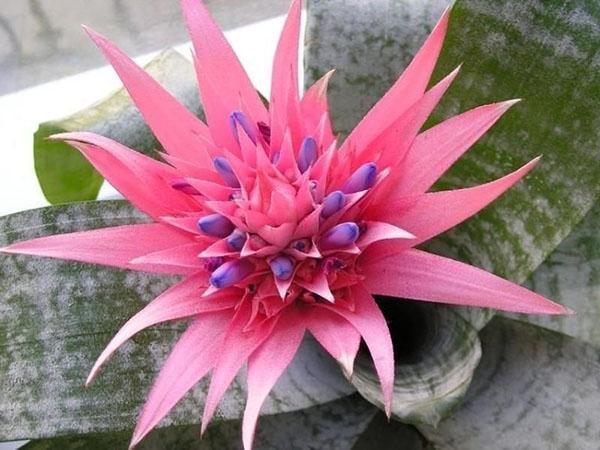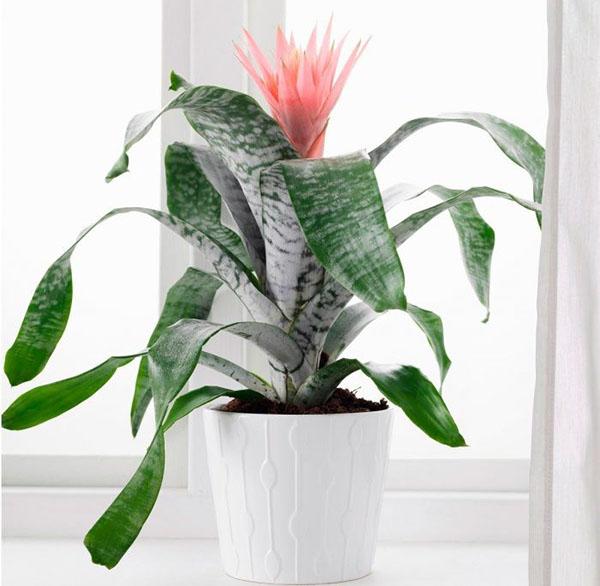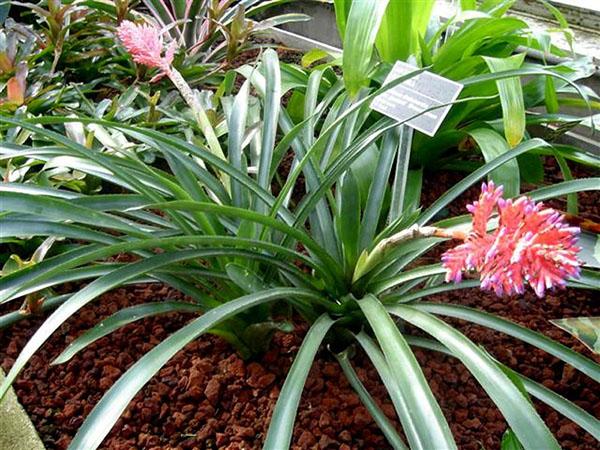How to care for an ehmeya flower at home and achieve the desired flowering
 How to care for an ehmeya flower so that it delights with flowers? The unusual shape of the bracts and the elegant color of the leaves make this plant a decoration of any room. Growing ehmea has its own characteristics that a florist needs to know about.
How to care for an ehmeya flower so that it delights with flowers? The unusual shape of the bracts and the elegant color of the leaves make this plant a decoration of any room. Growing ehmea has its own characteristics that a florist needs to know about.
Plant features

In the natural environment of the echmea, there are more than 170 species in South and Central America. For home breeding, the most popular variety is Ehmeya Striped, which has strong white-green dense leaves and pink, delicate shade, flowers. In diameter, the rosette of an adult plant can reach one meter, and the length of the inflorescence is about 30 cm.The leaves of this species grow up to 60 cm in length and 6 cm in width.
Each of the leaf rosettes produces only one bloom.
Despite all the decorativeness, the plant requires special care from the grower. Such a popular striped echmea contains poison. In this regard, all work is recommended to be carried out in protective rubber gloves. After finishing work with a flower, you should definitely wash your hands. Contact with a plant without protection may cause skin irritation.
How to care for an ehmeya flower correctly
 Almost all varieties of echmea are large plants that require ample space.
Almost all varieties of echmea are large plants that require ample space.
Home to a warm climate, Ehmeya grows best at around 25 ° C in summer and 10 ° C less in winter. A natural drop in temperature at night, compared to daytime, stimulates flowering.
Lighting
 How to care for an ehmea flower? The rules include determining the location of the flower pot. The best lighting mode for ehmea is created by placing the plant on either west or east facing windows. Under these conditions, the flower receives enough light without the likelihood of suffering from aggressive exposure to sunlight from the south.
How to care for an ehmea flower? The rules include determining the location of the flower pot. The best lighting mode for ehmea is created by placing the plant on either west or east facing windows. Under these conditions, the flower receives enough light without the likelihood of suffering from aggressive exposure to sunlight from the south.
An exception is the curved echmea, which requires abundant lighting. And most of all, the shining ehmeya should be protected from the sun on the leaves.

Fertilization
 Why does not ehmeya bloom at home, and grows poorly? This may be due not only to watering, lighting and non-compliance with the temperature regime, but also to the lack of feeding. Suitable for this flower mineral complex fertilizer, released in liquid form.
Why does not ehmeya bloom at home, and grows poorly? This may be due not only to watering, lighting and non-compliance with the temperature regime, but also to the lack of feeding. Suitable for this flower mineral complex fertilizer, released in liquid form.
Fertilization procedure:
|
Season |
Application frequency fertilizers |
| Spring | 1 time in 15-20 days |
| Summer | |
| Autumn | 1 time per month |
| Winter | Once every 1.5 months |
Watering and moisture
 How to water ehmeya is determined based on the season. In spring and summer, watering should be done immediately after the topsoil has dried. In this case, the water should not be cold and well-separated. It should be poured directly onto the outlet itself and under the bush.
How to water ehmeya is determined based on the season. In spring and summer, watering should be done immediately after the topsoil has dried. In this case, the water should not be cold and well-separated. It should be poured directly onto the outlet itself and under the bush.
With the coming of autumn watering cut. Until spring, it is carried out only under a bush, so as not to expose the flower to the danger of rotting.
Moisturizing the soil should be supplemented by humidifying the air, this is especially important during the heating season.In the absence of additional spraying, the plant will not die, but for good development this condition must be observed.
Placing an echmea flowerpot on a pallet of wet pebbles will help create the right humidity.
Bloom
 The plant gives beautiful large flowers only once. A simple method used by flower growers will help to stimulate the beginning of flowering. It is necessary to place a flower pot with a plant in a plastic bag with two ripe apples. The bag is loosely tied and left in this form for 10 days. If everything is done correctly, flowering will begin in 4 months.
The plant gives beautiful large flowers only once. A simple method used by flower growers will help to stimulate the beginning of flowering. It is necessary to place a flower pot with a plant in a plastic bag with two ripe apples. The bag is loosely tied and left in this form for 10 days. If everything is done correctly, flowering will begin in 4 months.
How often does ehmeya bloom? With a lack of lighting, there may be no flowering at all, and the bright decorative color of the leaves will fade. If the care of the plant is good, then each of the outlets gives one flowering after 1-3 years, after which it requires renewal by planting new plants.
Transfer
 To grow echmea in a house or apartment, you can use an ordinary flower pot. After the drainage layer, a mixture is poured into the pot, consisting of equal parts of sand and peat, plus twice the volume of deciduous soil.
To grow echmea in a house or apartment, you can use an ordinary flower pot. After the drainage layer, a mixture is poured into the pot, consisting of equal parts of sand and peat, plus twice the volume of deciduous soil.
You can buy ready-made potting mix for growing bromeliads.
To make the plant look fresh and please with flowering, a transplant is necessary as it grows. It is advisable to carry it out in the spring, after the plant has finished blooming. This removes those rosettes that have already faded.
Reproduction

You can use 2 types of plant propagation:
- seeds;
- offspring.
The most commonly used vegetative method. Since echmea reproduces by shoots, young sockets are immediately separated during transplantation. The size of the pots is selected commensurate with the size of the plant itself. Sections of the separated young offspring are treated with charcoal before planting to prevent rotting.
 Growing from seed is used less frequently than dividing the plant. When cultivated with seeds, new plants may lose their characteristic varietal characteristics.
Growing from seed is used less frequently than dividing the plant. When cultivated with seeds, new plants may lose their characteristic varietal characteristics.
Reproduction of echmea by shoots gives a guaranteed result, moreover, a separated plant will be ready to bloom faster than one planted with seeds.
Diseases and pests
 With poor maintenance, the plant may lose color and not bloom. With excessive humidity, as well as in the case of improper watering, rot can affect the ehmeya.
With poor maintenance, the plant may lose color and not bloom. With excessive humidity, as well as in the case of improper watering, rot can affect the ehmeya.
Among the most common pest infestations are the following:
- aphid;
- scabbards;
- root worm.
Insecticides will help to deal with pests.
It is not at all difficult to properly care for an ehmeya flower. Separating and seating the "kids" you can get new plants that will delight with their flowering and give life to new young offspring.